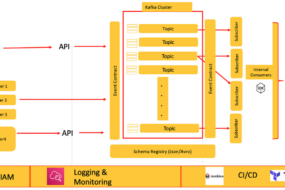
Welcome to our comprehensive guide on building agile applications for today’s market through microservices and database integration. In this article, we delve deep into the intricacies of merging microservices architecture with database systems, offering insights and strategies to create adaptable and responsive applications. Let’s embark on a journey to understand how this integration revolutionizes the development landscape.
Understanding Microservices Architecture
Microservices: The Foundation of Agility Microservices architecture, also known as microservices, is a design pattern that structures applications as a collection of loosely coupled services. Each service is self-contained, focusing on a specific business capability and communicates with other services through APIs. This modular approach enhances flexibility, scalability, and resilience, enabling faster development cycles and easier maintenance.
Benefits of Microservices
Scalability: Microservices allow independent scaling of services based on demand, optimizing resource utilization.
Flexibility: Decoupled services facilitate technology diversity, empowering teams to choose the most suitable tools and technologies for each service.
Fault Isolation: Isolated services minimize the impact of failures, ensuring robustness and fault tolerance.
Continuous Deployment: Independent deployment of services enables continuous delivery, accelerating time-to-market and facilitating iterative development.
Integrating Databases with Microservices
Challenges of Database Integration Integrating databases with microservices poses several challenges, primarily due to the decentralized nature of microservices architecture. Traditional monolithic databases are ill-suited for microservices, leading to issues such as data consistency, transaction management, and schema evolution.
Strategies for Database Integration
Database per Service: Adopting a database per service approach ensures that each microservice has its database, promoting autonomy and isolation.
Event-Driven Architecture: Implementing event-driven communication between microservices using messaging queues or event streams facilitates asynchronous data propagation and maintains loose coupling.
Polyglot Persistence: Embracing polyglot persistence allows using multiple database technologies within the same application, optimizing data storage for each microservice’s requirements.
Implementing Agile Applications
Agile Development with Microservices and Databases Combining microservices architecture with database integration lays the foundation for agile application development, empowering organizations to respond swiftly to changing market dynamics and customer demands. Agile applications built on this architecture exhibit the following characteristics:
Modularity: Applications are composed of independent, reusable microservices, facilitating iterative development and continuous integration.
Scalability: Scalable microservices architecture ensures that applications can handle varying workloads and scale horizontally when needed.
Resilience: Decentralized architecture enhances fault tolerance and resilience, minimizing service disruptions and downtime.
Adaptability: Microservices architecture enables quick adaptation to evolving business requirements, allowing organizations to stay ahead in today’s dynamic market landscape.
Embracing the Future of Application Development
The Evolution Continues As technology advances and market demands evolve, the integration of microservices and databases will continue to shape the future of application development. Organizations must embrace this paradigm shift, leveraging agile methodologies and innovative technologies to stay competitive and deliver value to their customers.
Final Words
In conclusion, the amalgamation of microservices architecture and database integration heralds a new era of agile application development. By embracing this approach, organizations can build robust, scalable, and adaptable applications that meet the demands of today’s fast-paced market. The journey towards building agile applications begins with understanding the principles and strategies outlined in this guide. Embrace change, empower innovation, and embark on the path to building agile applications for today and tomorrow.
Commonly Asked Questions
1. How does microservices architecture enhance scalability?
Microservices allow independent scaling of services based on demand, optimizing resource utilization and ensuring scalability without impacting other components of the system.
2. What are the key challenges of integrating databases with microservices?
Challenges include data consistency, transaction management, and schema evolution, primarily due to the decentralized nature of microservices architecture.
3. How does event-driven architecture facilitate database integration with microservices?
Event-driven communication enables asynchronous data propagation between microservices, ensuring loose coupling and facilitating seamless database integration.
4. Why is polyglot persistence recommended for microservices architecture?
Polyglot persistence allows using multiple database technologies within the same application, optimizing data storage for each microservice’s requirements and promoting autonomy.
5. How does agile application development benefit from microservices and database integration?
Agile applications built on this architecture exhibit modularity, scalability, resilience, and adaptability, empowering organizations to respond swiftly to changing market dynamics and customer demands.
Advertisement








